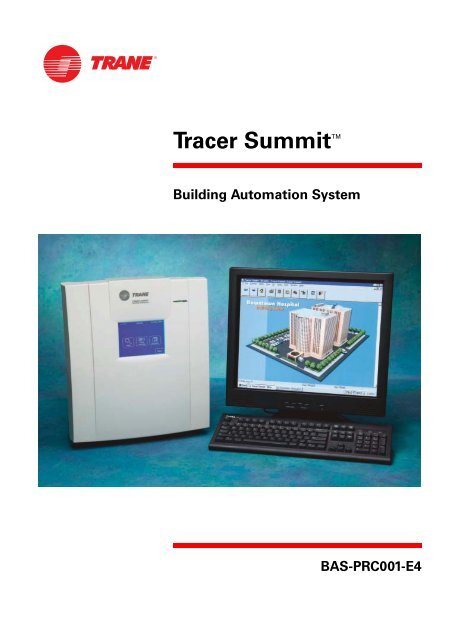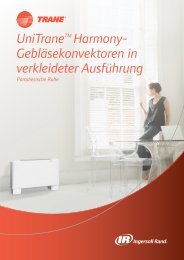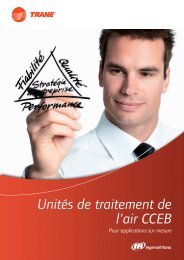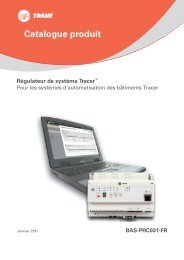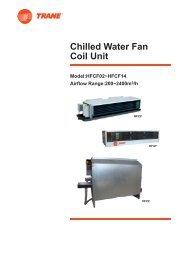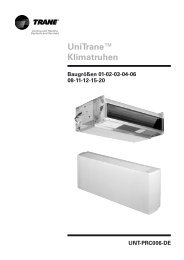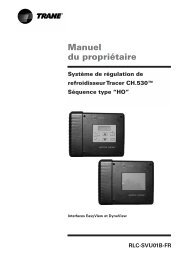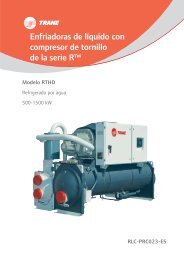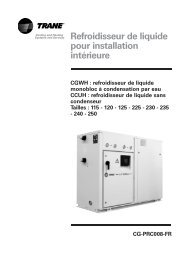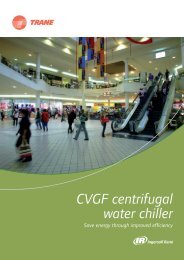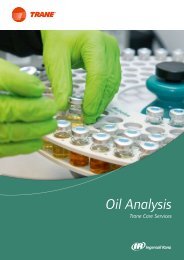Tracer Summit⢠- Trane
Tracer Summit⢠- Trane
Tracer Summit⢠- Trane
You also want an ePaper? Increase the reach of your titles
YUMPU automatically turns print PDFs into web optimized ePapers that Google loves.
<strong>Tracer</strong> Summit Building Automation SystemcuBAS-PRC001-E4
Features and benefitsEase of serviceThe optional Rover service tool can belaunched from <strong>Tracer</strong> Summit softwareto identify problems, test functionality,change configuration, create and editprogramming, and monitor statusinformation for LonTalk unit controllerson the system. From an operator onsite, to a technician several miles awayusing a remote connection, thecombination of <strong>Tracer</strong> Summit softwareand a Rover service tool provide thedata and functionality required to fullyand conveniently service the buildingautomation system.Chiller plant controlThe <strong>Tracer</strong> Summit chiller plant controlapplication provides intelligent controland comprehensive monitoring ofsystem components, including:• Multiple chillers• Related pumps and valves• Cooling towers and ice tanksThe chiller plant control applicationbalances system efficiency andequipment runtime to optimize systemperformance. The application alsoprovides status information that canhelp with troubleshooting. The statusinformation indicates what ishappening in the chiller plant as well aswhat to expect next, based on currentoperating conditions. The chiller plantcontrol program is suitable for bothcomfort and industrial applications, aswell as control sequences includingthermal storage and dual-fuel chillersystems.Area controlArea control coordinates HVACequipment and lighting for a specificarea of the building.Unit controllers and binary outputs areassigned as members of a commonarea, which makes it easy to changesetpoints, do scheduling, and performoverrides at the PC Workstation.Trend ViewerThe Trend Viewer (see Figure 2) allowsthe user to track data over time; tooverlay alarms, events, and overrides;and to collect trended data that spanslong time periods. Trend data is storedon a database on the PC Workstation.Note: The PC Workstation must be onlineand connected to the BCU to capturecontinuous data from the BCU. The BCUtemporarily caches trended values, so if aconnection is lost for a short amount oftime, no gaps will be seen in the data.Timed overrideAs a part of the Area Controlapplication, the timed override featureenables building occupants andmanagement staff to temporarilyoverride HVAC and lighting equipment.Users can perform overrides from thezone sensor, the BCU operator display,the <strong>Tracer</strong> Summit PC Workstationsoftware, or the <strong>Tracer</strong> SummitWebOPS.Variable-air-volume airsystem (VAS)The <strong>Tracer</strong> Summit variable-air-volumeair system (VAS) control coordinates airhandling units and VAV boxes within abuilding. VAV units are assigned to theair-handling unit that supplies air tothem. A VAS control starts up andshuts down the system to assureproper static pressure control. Energysavingapplications, including staticFigure 2. Trend Viewerpressure optimization and ventilationoptimization, are available as standardVAS control features for LonTalksystemsIndoor air quality controlIndoor air quality is an issue of risingimportance from the perspectives ofcomfort as well as governmentalregulation and liability. A <strong>Tracer</strong> Summitsystem intelligently monitors indoor airquality to make maintaining it easy.Custom programmingA powerful custom programminglanguage (CPL) allows systemcustomizing for specific applications.Typically, CPL routines are created tosequence equipment, calculatesetpoints and values, and performshutdown sequences.Managing multiple facilitiesTo assist in managing multiple facilitylocations, the <strong>Tracer</strong> Summit EnterpriseManagement Package includes utilitiesthat help the daily operator work moreefficiently. For example, a typical task ismaking the same or similar changes totime-of-day schedules across multiplelocations. The Enterprise ManagementPackage offers the ability to performBAS-PRC001-E4 5
Features and benefitsglobal schedule changes, which meansthat one simple schedule change canbe duplicated across an entireenterprise or group of facilities.Advanced alarmingThe advanced alarming features of a<strong>Tracer</strong> Summit system include thefollowing:• Alarm categories: Five optional, configurablealarm categories have beenadded. Alarms can be categorizedaccording to their severity, for example.Alarm filtering allows alarmswithin a category to be viewed atone time. A button appears on thetask bar for each category that hasbeen configured. The number ofalarms for that category is shown onthe button (see Figure 3.)• Pop-up messaging: Alarm categoriescan be configured to trigger pop-upmessages. Comments can beentered in a pop-up message thatshow up in the event log• Event log: A column has been addedto the event log for the new alarmcategories and for the commentsfield. Event log columns can be hiddenand widths can be expanded.The event log configuration is automaticallysaved after set up• Cell phone: Text messages can berouted from a <strong>Tracer</strong> Summit systemto a cell phoneWith either the Building ManagementPackage option or the EnterpriseManagement Package option added toa <strong>Tracer</strong> Summit system, after-hoursforwarding of alarms can be scheduledto be sent to various people by e-mail.This function closely models how anafter-hours and weekend call center isscheduled. Once the alarm messagehas been received, the on-call personcan use the powerful filtering featuresof the <strong>Tracer</strong> Summit alarm and eventlog to assist in troubleshooting anyequipment or system issues with theparticular facility in question.The Building Management Package andthe Enterprise Management Packageallow flexible scheduling of systemadministrative tasks to occur duringtimes when the normal systemoperator is not at work, for instance, atnight. Certain tasks such as gatheringreport and alarm data from the remotefacilities can be scheduled to occur at aconvenient time or when the telephonerates are the lowest if dial-upconnections are usedTime-of-day schedulingTime-of-day scheduling (see Figure 3) isone of a facility's most importantenergysaving strategies. Making surethat equipment runs only when it isneeded ensures that energy usage isminimized.Schedules for equipment serving aspecific area of the building areaccessed by viewing the graphic forthat area, and then clicking theSchedule button on the task bar.Figure 3. Scheduling editor6 BAS-PRC001-E4
Features and benefitsSchedules can be used for:• Keeping the equipment running atminimal energy-use levels onweekends and holidays• Creating exception schedules fortimes in which the schedule needs todeviate from the standard one• Performing optimal start and stop ofequipment to optimize energy usewhile maintaining comfortrequirements• Changing setpoints at specific timesof dayEngineered smoke control<strong>Tracer</strong> Summit software can be used tocontrol an automatic smoke-controlsystem. When used with a fire alarmcontrol panel (provided by othersuppliers), <strong>Tracer</strong> Summit software canhelp protect occupants by controllingthe flow of smoke in an emergency. Inaddition to smoke control, with afirefighter's control panel, thefirefighter can see the status of smokecontrol and implement overrides asrequired.MigrationExisting <strong>Tracer</strong> systems can easilymigrate to the current technologies of<strong>Tracer</strong> Summit systems. Upgrading a<strong>Tracer</strong> 100 system provides benefitsincluding network communications,state-of-the-art user interface, and theability to connect to multiplegenerations of controllers.For facilities where system upgradesare prohibitive, <strong>Tracer</strong> Summit systemsalso allows integration of <strong>Tracer</strong> 100and legacy Tracker systems. A <strong>Tracer</strong>Summit system can communicate withmost of the controllers in <strong>Tracer</strong> 100and Tracker systems. The integration oflegacy systems into the <strong>Tracer</strong> Summitworkstation allows the facility orenterprise operator to manage allfacilities with a single workstation.System integration<strong>Tracer</strong> Summit systems provides opensystem options that provide thefollowing capabilities:• Allows easy integration ofequipment and auxiliary systems intoa single system, or multiple buildingsinto a single network, which can beoperated from a single location• Assures competitive bidding forsystem additions and modifications• Provides an easy method to connect<strong>Trane</strong> equipment and <strong>Tracer</strong> Summitsystems into other BAS orSupervisory Control and DataAcquisition (SCADA) systems.The goal of any interoperable system isto provide an economical, reliable, andrepeatable solution. By basing <strong>Tracer</strong>Summit technology on open standardprotocols, this goal is easilyaccomplished. The use of openstandard protocols assures long-termsupport across a broad number ofsuppliers.<strong>Trane</strong> has experience in providingintegrated, interoperable solutions onthousands of installations. These rangefrom simple HVAC solutions thatcombine <strong>Tracer</strong> controllers withvariable frequency drives, tosophisticated installations thatcombine many building sub-systems.For more information, see theInteroperable Solutions brochure (BAS-SLB004-EN) and the Connections CD(BAS-CMC002-EN)BACnet supportAn open, standard protocol is essentialfor building control system integration.The <strong>Tracer</strong> Summit system uses theBACnet protocol to facilitatecommunication between <strong>Tracer</strong>Summit BCUs and PC Workstations aswell as a means to integrate productsand systems, including fire panels,fume hoods, and non-<strong>Trane</strong> BAS orHVAC equipment. <strong>Trane</strong> is a member ofthe BACnet Manufacturers Association.For more details on BACnet, refer towww.bacnet.org.LonTalk ® supportThe BCU includes native support forLonTalk-based controllers. The <strong>Trane</strong>implementation of LonTalk utilizestwisted-pair physical media. In additionto <strong>Tracer</strong> controllers, anyLonTalkcompatible controller can beincluded on a LonTalk link. Thesedevices must use FTT-10A or FT-X1transceivers and support LonTalkstandard network variable types(SNVTs). This allows for easyintegration of devices such as variablefrequency drives, lighting, security,humidifiers, and boilers.<strong>Trane</strong> is a sponsor of the LonMark ®Interoperability Association. For moredetails on LonMark, refer towww.lonmark.org.Other protocol supportWhile support for open standardprotocols is the preferred method ofintegrating systems and systemcomponents, gateways are anothermethod that can be used for thispurpose. A gateway translates one setof communication rules to another,allowing devices that use differentprotocols to pass data to each other.The use of these gateways is the idealsolution to:• Interface with controllers such asmeters, variable frequency drives,fire alarm systems, and security• Provide HVAC data out to aproprietary BAS, or to a SCADAsystem for industrial applicationsThe <strong>Tracer</strong> Summit communicationsbridge is a gateway that enables a widevariety of devices that use theMODBUS RTU protocol to connect to a<strong>Tracer</strong> Summit building automationsystem using BACnet. The bridge canalso be programmed to interface toother common communicationprotocols.A cost effective integration platform, socalled PIC, can also be provided fordata exchange between <strong>Tracer</strong> Summitand <strong>Trane</strong> controls to MODBUS,master type, devices.BAS-PRC001-E4 7
System architectureThe <strong>Tracer</strong> Summit system architectureis highly distributed (Figure 4). Controlcan occur at the appropriate systemlevel to ensure integrity.The three levels of control are:• Operator interface• Building control• Unit controlFigure 4. <strong>Tracer</strong> Summit system architecture▲InteroperabilityWWW▲ ▲Managementlevel▲Web Server<strong>Tracer</strong> Summit TM LCD Touch ScreenBCUField ServerOperatorInterfaceBuildingControls▲AutomationlevelZN523MP581MP583Site installedUnit Controls▲FieldlevelPower panelcontrolZSMLightingcontrolEnergymeteringPICAlarm controlandmonitoringMP501/MP5033rd partyequipmentcontrolEX2BuildinginformationmonitoringField devicesControl,measure,monitoringIntegrationRTHD HFO/HFR VariTrac TM CGAN/CXAN CLCE Voyager TMHVACEquipmentwith Factory-MountedControls▲▲8 BAS-PRC001-E4
Operator interfaceOperators have three interface optionsfor managing their building automationsystems:• PC Workstation• Operator display• <strong>Tracer</strong> Summit WebOPSPC WorkstationThe <strong>Tracer</strong> Summit PC Workstationsoftware provides a graphical userinterface for setting up, operating, andmodifying the building automationsystem. This interface along with theuse of Microsoft Windows and InternetExplorer make building operation aseasy as surfing the World Wide Web.<strong>Tracer</strong> Summit PC Workstationsoftware can be run on a PC located atthe building site or from a remotelocation. The software can also be usedto connect to and monitor operationsfor multiple building sites. For example,a user can view the status of a chillerlocated in the next room, whilemodifying the schedule for a buildingthat is across the city or around theworld.<strong>Tracer</strong> Summit PC Workstationsoftware runs with Microsoft Windows2000 Professional or Windows XPProfessional operating systems.Operating with Windows offers theflexibility of running other popularapplications for communications andoffice productivity. See Hardwarerequirements on page 14 for more PCWorkstation details.The <strong>Tracer</strong> Summit PC Workstation isthe most common interface foraccessing building automationsystems. The primary features aredescribed in this section.Alarm processing and event logThe daily operator must be able to dealeffectively with abnormal conditions.When the system detects such acondition, it routes the alarm to theappropriate PC Workstation(s), pagers,cell phones, and e-mail addresses.At the PC Workstation, alarms andother system events are stored in thealarm and event log. The alarm andevent log have five optional,configurable alarm categories that canbe used to filter and sort the alarms.Sorting can be based, for example, onseverity level.If another application is in use when anabnormal condition occurs, an alarm isindicated in the task bar at the bottomof the screen. Pop-up messages canalso be associated with alarms, to alertthe user of the abnormal condition.The event log displays critical dataabout the alarm including whichbuilding it is from, whether it requiresan acknowledgment, and anycomments that may have been enteredin the popup dialog box.Critical alarms can be set up withmessages and graphics that can aid introubleshooting problems.A series of easy-to-use filters can beused to show only desired events: Forexample, a filter can be used to viewalarms only from a specific building, toview alarms received only at a specifictime, or only alarms from a specificalarm category.Graphics<strong>Tracer</strong> Summit uses graphics as ameans of viewing and navigatingthrough the system, much like walkingthrough the building. Graphics showdata related to building environments,including climate, lighting, and othercontrollable operations. Graphics canbe used to change setpoints andoverride equipment operation.Putting graphics in groups makes itpossible to move logically from place toplace within a building. Target buttonscan be added to graphics to providelinks to related sources.The navigation tree, a hierarchical,treestyle representation showing therelationship of all graphics for a facility(see Figure 1 on page 4), provides away to move between graphics andbuildings. The navigation tree is astandard part of every system and canbe easily modified.Forward, Back, and Home buttons onthe menu bar provide another way tomove among graphics.Graphics library and graphics editingA library of standard graphicsrepresenting all <strong>Trane</strong> equipment andapplications is included in the <strong>Tracer</strong>Summit software. In addition, standard3D graphics provide a better visualrepresentation of equipment alongwith relevant equipment information.These standard graphics have beentested to provide a consistently highlevel of quality and usability.Custom graphics can also be createdby incorporating visual elements fromthe building, such as floor plans orexterior views from CAD drawings, intostandard graphics. Custom graphicscan also include digital photographyand animated images such as arotating fan.Graphics can include the followingelements:• Any data available in the system as anumerical or text value• Analog values that can change colorsbased on deviation from a desiredvalue for quick recognition ofoperational issues• User-defined static text in a widechoice of fonts and colorsBAS-PRC001-E4 9
Operator interface• Animation using images to representbinary and analog values, animatedGIF, or video (AVI) files• Hyperlinked text and images that canbe added to move between graphics• Hyperlinks to any Windowscompatiblefiles or applications (forexample, Adobe Acrobat documents,Excel spreadsheets, and externalWeb sites)• Multiple graphic images thatconform to the industry standardJPEG, GIF, or BMP formats, inaddition to the library of HVACequipment images included with the<strong>Tracer</strong> Summit software package• Charting of historical trends orrealtime values• User controls including push buttons,check boxes, drop-down list boxes,and entry fields• A hand icon appearing on overridebuttons when controls areoverridden• Representation of equipment status,for example, a thermal storage tankat 40% of its capacityData, text, setpoint overrides, andother information can be added tographics by using the Graphics editorthat is part of the software package.This editor allows any user with propersecurity to create or modify graphics.Tools available in the Graphics editorcan align graphical elements,determine which elements appear ontop, and perform cut, copy, and pastefunctions.Reports and trendsViewing current, as well as previoussystem operations, provides invaluableinformation. The <strong>Tracer</strong> Summit reportsand trends feature provides this ability.Trends can present a variety of datasamples at defined intervals to show ata glance the historical and currentstatus of the facility. These trends canbe graphically viewed on the screen,printed out, and stored on disk.To create a new trend, the user rightclickson a status or control point(for example, space temperature) on agraphic, and then selects Create TrendViewer. Additional points can be addedto the trend in a similar manner. Anypoint associated to a trend willautomatically be archived by theworkstation, for a period of up to tenyears. These data can be displayed inthe integrated trend viewer tool.Standard reports for each piece of<strong>Trane</strong> equipment provide a valuablesource of record-keeping andtroubleshooting data, commissioningreport can, as an example begenerated by few mouse clicks.In addition, standard reports areprovided for ASHRAE Guideline 147,Monitoring of large tonnage chillers.Finally, custom reports can be definedfor any desired values, such as energyusage or run-time reporting.PC Workstation system utilitiesIn addition to operations andconfiguration, the <strong>Tracer</strong> Summit PCWorkstation software also providesutilities for management of the system.• Save and restoreWhen connected to a network ofBCUs, the PC Workstation softwareconstantly analyzes database statusand updates information on the PChard drive.Database changes made by otherworkstations are automaticallyreflected at each PC without the needfor a central server. If a BCU goesoffline, the PC Workstation softwareautomatically reloads its databasewithout the need for intervention.The system database can be archivedor backed up for local or offsite storageof data in case it is needed for restoringthe system in the event of a problem.• SecurityA sophisticated password systemprotects the <strong>Tracer</strong> Summit systemfrom unauthorized access. Eachoperator logs on to the system and hasaccess to only the applications, editors,objects, and properties to whichaccess rights are assigned.An operator with proper security canaccess all levels of the system and hasthe ability to alter passwords.• Diagnostics<strong>Tracer</strong> Summit constantly evaluates allof the system parameters and reportsabnormal conditions to the operator.Problems ranging from acommunication failure due to a brokenwire to the failure of a sensor areautomatically detected and reported.• Network management functionsThe <strong>Tracer</strong> Summit PC Workstationsoftware includes field panel reset andrestore, abnormal conditionmonitoring, network routing, andBACnet support.• Configuring controllersThe <strong>Tracer</strong> Summit PC Workstationsoftware can be used to configure andtroubleshoot controllers found on <strong>Trane</strong>equipment. This setup consists ofsetpoints, minimum on and off times,and other user-defined parameters.PC Workstation additionalcapabilities<strong>Tracer</strong> Summit PC Workstationsoftware has four add-on softwarepackages that provide additionalcapabilities.With the <strong>Tracer</strong> 100/TrackerCommunication package, the PCWorkstation can communicate with,and receive alarms from, <strong>Trane</strong>'s legacysystem controllers.The Building Management packagemakes it easy to schedule sitecommunication and database back-upsduring after-hours operation. Thispackage also allows scheduling ofalarms, in the form of e-mailmessages, to appropriate personnel. E-mails can be sent to any device thatcan receive email messages.The Enterprise Management packageincludes all of the features of the othertwo add-on packages and also allowschanges to be applied across multiplelocations. In addition, the packageallows multiple PCs to share data, theevent log, and graphics with a centralPC.The <strong>Tracer</strong> Summit Critical ControlSystem package is an enhancedversion of <strong>Tracer</strong> Summit software thatprovides complete environmentmanagement for FDA-regulated areas,from research to distribution.10 BAS-PRC001-E4
Operator interfaceOperator displayThe optional <strong>Tracer</strong> Summit BCUoperator display provides an easy-touseinterface for:• Viewing equipment and system statusinformation• Making changes to time-of-dayschedule• Changing system setpoints• Viewing the alarm and event log• Performing timed overridesThe operator display is an intuitive,touch-screen display that is located onthe front of the <strong>Tracer</strong> Summit BCU.The operator display can also showgraphical images indicating the type ofequipment or area that is beingcontrolled by the <strong>Tracer</strong> Summitsystem.The BCU operator display offers a wayto make daily operation changes to thesystem without the need for a PCWorkstation at the facility. For a facilitywith multiple BCUs, information for theentire <strong>Tracer</strong> Summit system can beaccessed through a single operatordisplay.<strong>Tracer</strong> Summit WebOPSThe <strong>Tracer</strong> Summit WebOPS providesthe ability to operate a <strong>Tracer</strong> Summitbuilding automation system (BAS) fromany PC using a Web browser, such asInternet Explorer. WebOPS accessesreal-time system data from the <strong>Tracer</strong>Summit system and sends it to theWeb browser interface. This allowsaccess to system information fromwithin a facility or from a remotelocation anywhere in the world using aWeb browser rather than <strong>Tracer</strong>Summit software.With a WebOPS installed on a <strong>Tracer</strong>Summit system, any PC with a Webbrowser can be used to:• View graphical information about afacility, change setpoints, and performoverrides• View and change schedules• View and acknowledge alarms• View historical informationWebOPS can be easily added to a newor existing <strong>Tracer</strong> Summit installation. Itis compatible with <strong>Tracer</strong> Summitinstallations Version 13 and higher withEthernet, BACnet/IP, or ARCNETconnections.<strong>Tracer</strong> ES<strong>Tracer</strong> ES is web-based, buildingautomation software that worksseamlessly with existing <strong>Tracer</strong>Summit systems. It dramaticallysimplifies managing and operatingmultiple facilities, letting owners andoperators have an enterprisemanagement view of all of buildingcontrol systems. <strong>Tracer</strong> ES allowsaccess to information about anybuilding from any secure PC that isconnected to the Internet.<strong>Tracer</strong> ES provides easy integration andcompatibility with a <strong>Tracer</strong> Summitsystem:• Easily connects with existing ITinfrastructure• Runs on a central server with SQLdatabase• Seamlessly works with an existing<strong>Trane</strong> <strong>Tracer</strong> Summit system• Integrates with any non-<strong>Trane</strong>BACnet building systemBAS-PRC001-E4 11
Building controlThe <strong>Tracer</strong> Summit BCU is anintelligent field panel thatcommunicates with unit controllers.Unit controllers provide stand-alonecontrol of HVAC equipment. The BCUscans all unit controllers to updateinformation and coordinate buildingcontrol, including building subsystemssuch as chiller plants.A site can have multiple BCUs and PCWorkstations connected over a localarea network (LAN). The LAN allowsthese varied components to bemanaged as one system.The BCU is housed in a protectiveenclosure that allows for easy accessto the termination and main circuitboards (see Figure 5).Figure 5. BMTX BCU board components12111099{{{12341 = Address DIP switch2 = Seven-segmentLED display3 = Modem card(optional)4 = Modem, phone lineconnector5 = Operator displayconnector6 = Ethernet connector7 = Binary inputs8 = LonTalk9 = Comm410 = Isolated Comm311 = EIA-232 BACnetport12 = 24 Vac powerconnector87{{5612 BAS-PRC001-E4
Unit controlThe <strong>Tracer</strong> Summit system providescentralized control for <strong>Trane</strong> HVAC andother unit-level equipment. <strong>Tracer</strong>Summit software supports thefollowing <strong>Trane</strong> equipment:<strong>Trane</strong> chillers• CenTraVac chiller with a UCP2 or a<strong>Tracer</strong> CH530 chiller controller• Series R CenTraVac chiller with aUCP2 or a <strong>Tracer</strong> CH530 chillercontroller• Scroll chiller with an IntelliPak,classic, or Scroll Manager Module(SMM) controller or CH532 controller• Absorption chillers with a UCP2,classic, or Horizon controller• Series R air-cooled and water-cooledchillers with CH530 chiller controller<strong>Trane</strong> airside equipment• Vari<strong>Trane</strong> with a <strong>Trane</strong> variable-airvolumecontroller (VAV II, III, and IV)or <strong>Tracer</strong> VV550 VAV Lon controller• VariTrac II changeover VAV system• Fan coil with a <strong>Trane</strong> terminal unitcontroller ZN523 controller• Air handler with a <strong>Tracer</strong> MP581, or<strong>Tracer</strong> AH540 controller<strong>Trane</strong> unitary equipment• Voyager rooftop air-conditioning unitwith UCP2 controller or Reliatelcontrollers• IntelliPak air-conditioning units• Water-source heat pump with a<strong>Trane</strong> terminal unit controller (TUC),<strong>Tracer</strong> ZN510 controller, or <strong>Tracer</strong>ZN524 controller• Precedent rooftop air-conditioningunits with ReliaTel controls<strong>Trane</strong> field-installedcontrollers• <strong>Tracer</strong> MP581 programmablecontroller• <strong>Tracer</strong> MP501 multi-purposecontroller• <strong>Tracer</strong> MP503 input/output module• <strong>Tracer</strong> ZN523 zone controller• <strong>Tracer</strong> ZN524 zone controller• <strong>Tracer</strong> AH541 air-handler controller• <strong>Tracer</strong> VV551 VAV controller• <strong>Tracer</strong> CH531 chiller controllerBAS-PRC001-E4 13
SpecificationsPC WorkstationHardware requirements<strong>Tracer</strong> Summit for Windows softwareruns on an IBM-compatible PC. For<strong>Tracer</strong> Summit standard software, theTracker 100/Tracker CommunicationsPackage, and the BuildingCommunications Package, the PC musthave the following minimum hardware:• Pentium 233 MHz processor• 128 MB RAM for Windows XPProfessional or Windows 2000Professional• 2 GB hard drive space with 300 MBfree space• 32X CD-ROM drive needed to run<strong>Tracer</strong> Summit Daily OperationsTutorial• 15-inch SVGA monitor, 800 x 600resolution, 16-bit color• Keyboard and mouse o Parallel portfor printer (optional)• 16-bit sound card with speakers• UPS is recommendedIn addition, at least one of the followingis required for establishing aconnection:• One PCI or ISA slot (for an Ethernetnetwork adapter)• One minimum 33.6 Kbaud modemfor remote workstation (option)The minimum hardware requirementsfor a PC Workstation running <strong>Tracer</strong>Summit Enterprise ManagementPackage are as listed in the previoussection for <strong>Tracer</strong> Summit standardsoftware, with the followingexceptions:• Pentium 700 MHz processor• 56 Kbaud modemSoftware requirementsThe PC Workstation must have thefollowing software installed:• Microsoft Windows 2000 Professionalor Windows XP Professional• Internet Explorer Version 5 or higher• Microsoft Data Access Components(MDAC) Version 2.8 Service Pack 1 orhigher (this is usually automaticallyinstalled with Microsoft Windows)SQL ServerIf the <strong>Tracer</strong> Summit EnterpriseManagement Package is used with aMicrosoft SQL Server, the serverhardware must meet the followingminimum hardware and softwarerequirements:• Windows 2000 or 2003 Server• Windows SQL 2000 (Standard orEnterprise) database• Pentium 933 MHz processor•256 MB RAM• 10 GB hard drive free space• UPS recommendedBCUPower requirementsNominal rating: 120/230 Vac; 50 or60 Hz; 1 pHMaximum current: 1.0 A at 120 Vacdedicated circuit breakerOperating environmentTemperature: From 32°F to 120°F(0°C to 50°C)Relative humidity: From 10% to 90%,non-condensingStorage environmentTemperature: From -50°F to 150°F(-46°C to 66°C)Relative humidity: From 10% to 90%,non-condensingEnclosureNEMA-1Weight15 lb (7 kg)MountingWall-mounted with #10 (5 mm) screwsMounting surface must be able tosupport 60 lb (28 kg)UL listingUL-916-PAZX – energy managementUL-864-UUKL – engineered smokecontrolCUL-C22.2 – signal devices-CanadaFCCFCC part 15, Class ACEEmissions EN61326:1998 Class BImmunity EN61326:1998Commercial Safety EN61010-1:2001ProcessorMotorola MCF5272 Cold FireMemoryFLASH 16 MBEEPROM 512 KBSRAM 1 MBSDRAM 8 MBBatteryNo battery is required. The clock ismaintained for a minimum of threedays by the super capacitor. All otherprograms are backed up by nonvolatilememory.Operator display (optional)¼ video graphics adapter (VGA) backlitliquid crystal display (LCD) with touchscreen4.5 in. × 3.4 in. (115.2 mm × 86.4 mm)5.7 in. (144.8 mm) diagonalResolution of 320 × 240 pixelsCommunicationsBACnet<strong>Tracer</strong> Summit systems communicatewith devices that support:• Communications based on theBACnet ASHRAE/ANSI 135 standard• ENV-1805-1/ENV-13321-1• 10BASE-T/100BASE-TX dedicatedEthernet (ISO/IEC 8802-3) orTransmission Control Protocol/Internet Protocol (TCP/IP) compatiblenetworkLonTalk<strong>Tracer</strong> Summit systems communicatewith devices that support• Communications based on theEIA-709.1 (LonTalk) standard• LonTalk standard network variabletypes (SNVTs)• FTT-10A or FT-X1 transceivers• Twisted-pair physical mediaMODBUS<strong>Tracer</strong> Summit systems communicatewith devices that support theMODBUS Remote Terminal Unit (RTU)protocol using the <strong>Tracer</strong> SummitCommunications bridge, or PIC device.14 BAS-PRC001-E4
SpecificationsFigure 8. Minimum clearances for the BMTX BCU enclosure300 mm600 mm1300 mm300 mm2900 mm1 = To fully open door2 = 1300 mm recommendedBAS-PRC001-E4 15
SpecificationsFigure 9. BMTX BCU enclosure dimensions123ACBDA = Top viewB = Front viewC = Left viewD = Right viewE = Bottom view1 = Knockout for 25 mm conduit2 = Knockout for 19 mm conduit3 = Knockout for 13 mm conduit(for ac wiring)ENote: Six of the twelve knockoutsare dual-sized knockouts for 25 mmand 19 mm conduit.16 BAS-PRC001-E4
SpecificationsBACnet PICS: BCUBasic informationVendor name<strong>Trane</strong>Product name<strong>Tracer</strong> Summit BCUStandard object typessupportedObject typesAnalog inputSupportCreatableDeletableProduct description<strong>Tracer</strong> SummitBuilding Control UnitAnalog outputCreatableDeletableBACnet standard application servicessupportedApplication service Initiate ExecuteCreateObject X XDeleteObject X XReadProperty X XReadPropertyMultiple X XWriteProperty X XWritePropertyMultiple X XConfirmedPrivateTransfer X XUnConfirmedPrivateTransfer X XReinitializeDeviceTimeSynchronization X XWho-HasI-HaveXXXBinary inputBinary outputDeviceData link layer optionBACnet/IP (Annex J)CreatableDeletableCreatableDeletableSupportedEthernet (ISO/IEC 8802.3), 10-BASE-TEthernet (ISO/IEC 8802.3), 100-BASE-TXPoint to point, EIA-232OtherBACnet/IP (Annex J)BBMDSupports foreign device registrationWho-Is X XI-Am X XSpecial functionsMaximum APDU size inoctetsSegmented requestssupported, window sizeSegmented responsessupported, window size47411Character sets supportedANSI, X3.4BAS-PRC001-E4 17
SpecificationsBACnet PICS: PC WorkstationBasic informationVendor nameProduct nameProduct description<strong>Trane</strong>BACnet standard applicationservices supported<strong>Tracer</strong> Summit PCWorkstation<strong>Tracer</strong> Summit PCWorkstationApplication service Initiate ExecuteCreateObjectDeleteObjectReadPropertyReadPropertyMultipleXXXXStandard object typessupportedDeviceData link layer optionSupportedEthernet (ISO/IEC 8802.3), 10-BASE-TEthernet (ISO/IEC 8802.3), 100-BASE-TXPoint to point, EIA-232OtherBACnet/IP (Annex J)BBMDSupports foreign device registrationSpecial functionsWritePropertyXWritePropertyMultipleXConfirmedPrivateTransfer X XUnConfirmedPrivateTransfer X XReinitializeDeviceXTimeSynchronizationXWho-Is X XI-Am X XMaximum APDU size inoctetsSegmented requestssupported, window sizeSegmented responses supported,window sizeCharacter sets supportedANSI, X3.44741118 BAS-PRC001-E4
<strong>Trane</strong>An American Standard Companywww.trane.comLiterature Order Number BAS-PRC001Date 1006ReplacesBAS-PRC001_0100Stocking LocationEuropeFor more information contactyour local district office ore-mail us at comfort@trane.comSince <strong>Trane</strong> has a policy of continuous product and product data improvement, it reserves the rightto change design and specifications without notice.


